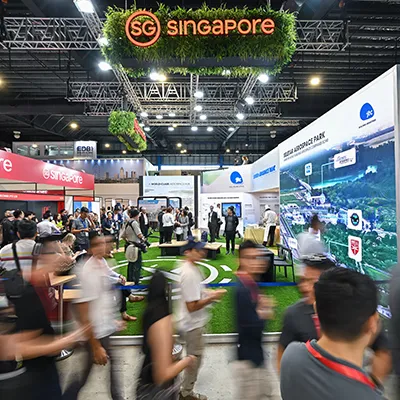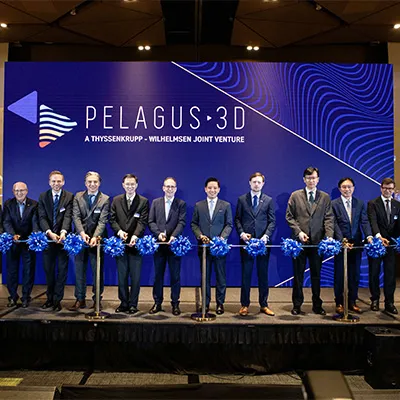In about five years, Infineon's back-end manufacturing plant at Kallang, Singapore will be transformed for the space age.
Building on the back of the Industry 4.0 blueprint, the German chipmaker will progressively introduce the latest trends in manufacturing, from a real-time global production network, end-to-end digital integration and manufacturing automation to the smart facility in Singapore.
The company recently introduced automated guiding vehicles transports chips to different parts of the facility. By 2020, robots will be manning the packing line, and loading and unloading of machines.
The smart factory will also digitally integrate the production process on the cloud, generating precious data that can help boost performance levels further. "Singapore is our choice location as a pilot site as we already have the foundation and cross functional competence in smart manufacturing. We can leverage on a conducive research and development ecosystem and supportive policies for high value added manufacturing in Singapore," said Mr. Chua Chee Seong, President and Managing Director of Infineon Technologies Asia Pacific.
The pilot is another sign of commitment in the company's 47 year-old relationship with Singapore, one which has seen the German company continually invest in its Singapore operations over the years.
Indeed, when it comes to innovation work, Singapore, which also functions as Infineon's Asia Pacific regional headquarters, is Infineon's preferred location to carry out innovation activities.
The company has two tracks of innovation. One is endogenous, focused on constantly improving its processes and operations by using new ideas, tools and technology. This includes building smart factories and newer, faster and better semi-conductor chips. The numerous patents it has filed is testament to this process.
The second is tracking the innovation on the outside. In order to protect itself against disruptive forces that arise out of this innovation, the company has to keep abreast of the trends that are taking place. The company is also hoping to work with some of the start-ups engaged in innovation.
Singapore plays a critical role in supporting both strands of innovation with the company.
Smarter way to manufacture
Infineon's research and development teams across its global offices follow the same philosophy: Innovation is about everything that creates positive business value.
"It can start as an invention, or an alternative or better process, a new product; a new technology, a new business model, a new sales model, a new process," said Mr. Jerome Tjia, the Senior Director and Head of Development Centre of Infineon Technologies Asia Pacific.
The Singapore Development Centre, a key research and development hub for Infineon in the Asia Pacific, focuses on several key areas in the chip manufacturing process. One area is in microelectronics, focusing on its architecture, design, product and test development, among others, said Mr. Tjia.
The centre also develops cutting edge and highly complex microcontrollers for the automotive industry. The applications range includes combustion powertrain, hybrid and electric drives, advanced driver assistance systems (ADAS) and networked cars of the future.
These have resulted in numerous patents for the company, some of which are proudly displayed at the company's main lobby.
But more than pride, these innovations bring important incremental improvements to their products.
"In product development, innovation focuses on understanding weaknesses, for example, in a customer’s system and deriving different means to overcome those weaknesses. As a result, the innovation should help to make the customers more successful," said Mr. Tjia.
Looking out, innovating within
While the company's research and development has produced strong results, Infineon is also paying close attention to what is happening on the outside.
In particular, the company is on the lookout for potentially disruptive forces, said Mr Rohit Girdhar, vice president for strategy and market development at Infineon Technologies Asia Pacific.
The way Infineon deals with this problem of disruption is to do three things: Scan the environment for potential threats, fix the pain points early and work with start-ups to develop new solutions that benefit Infineon.
First, the company wants to keep its focus on trends or issues that are just beyond the horizon or around the corner, to add an additional layer of protection against disruption. It does this by talking to its partners, clients and customers, said Mr. Girdhar.
"We are also looking at innovation which is coming from the markets and customers, from the inputs of external environments, what is needed tomorrow, what other technology trends, what kind of disruptions are happening," he said.
The second is to ensure that Infineon's customers are satisfied. And the company is doing this by taking a "build-to-order" approach.
"So we come in, we sit down with our customers and understand, where do they want to use our products. What matters to them most? Which external environment do they want to use our products? If so, are the products even the best ones for the customer or should we maybe design something else for them?" he said.
"So then if you think like that, from that angle, then your chance of getting disrupted is lowered."
Third, we work with external parties such as research institutions, universities, partners and start-ups to create solutions together. This ensures that we continually have access to some of the best ideas that are being generated outside Infineon.
To grow this ecosystem of innovation, the company had to look for a place that had a thriving ecosystem of top-tier research institutions, big companies and even small start-ups in Asia.
The answer was a no-brainer: Singapore.
Singapore: Strong government support, IP regime and talent pool
There are many big advantages that Singapore has over other Asian sites. For one thing, the government is supportive of getting companies to spur innovation activities.
Mr. Girdhar noticed that the government was open to sandbox experiments. Sandboxes are virtual spaces in which new technology can be tested, sometimes with real life data or examples.
Another advantage: Singapore's robust intellectual property environment. There is much less chance of IP loss with strong policies and favourable environment compared to other Asian locations.
Similarly, talent, which is crucial for any kind of innovation research, is plentiful.
"I was interviewing for my team and I had a great candidate from Peru who has been working in Singapore for three years applying for the role. I had never met anyone from Peru up till that point," he said, with a laugh.
"We are able to get talent from any part of the world and certainly the best Asian talent."
Lastly, the most commonly cited advantage – Singapore's location – is also one of the most important considerations when it comes to Infineon’s innovation activities.
This is because much of their externally-driven innovation relies on partnership and collaborations. And to be able to put a team together – an engineer, a researcher and a start-up – quickly is critical, especially in the light of a fast-changing business environment.
The set-up of this innovation team is relatively new – it was launched in November 2015 – but Mr. Girdhar is confident that Singapore will become a key part of the innovation ecosystem drive in the company because of the sheer advantages it brings to the table.
"All the different areas we look at are important: Innovation, production, technology, product development, application and customer and market. In Singapore we are really close to the customers and markets here. So all this, we are able to drive out of Singapore very effectively," he added.






